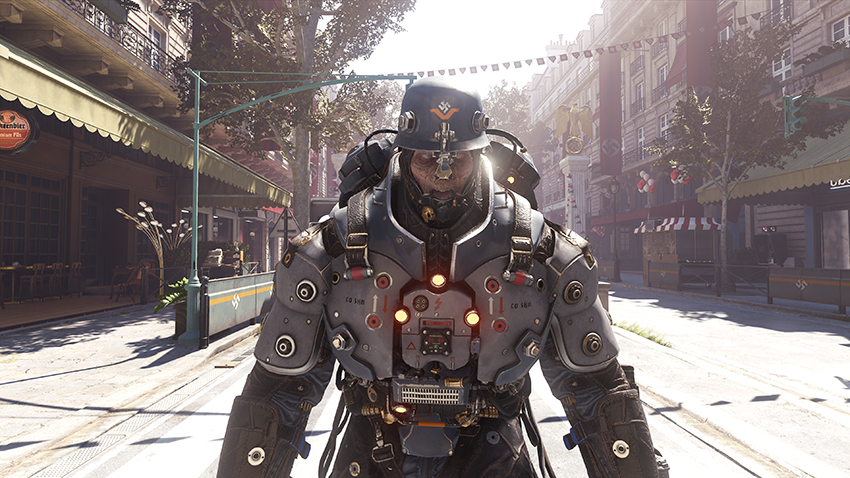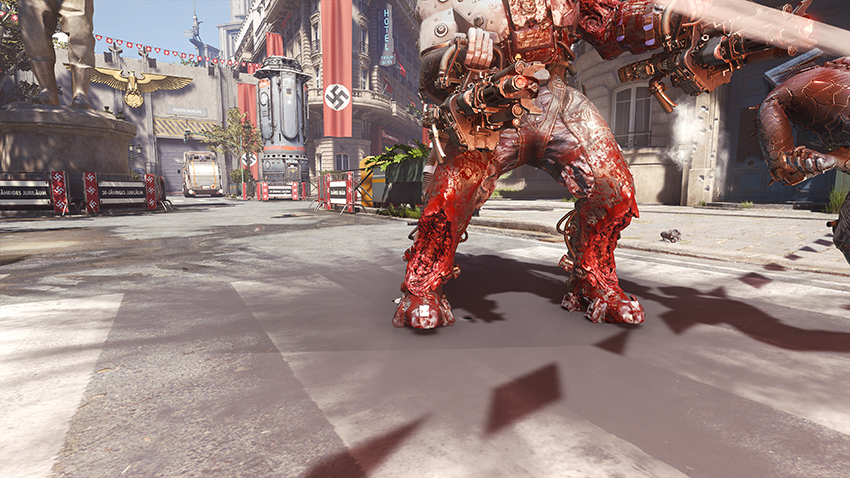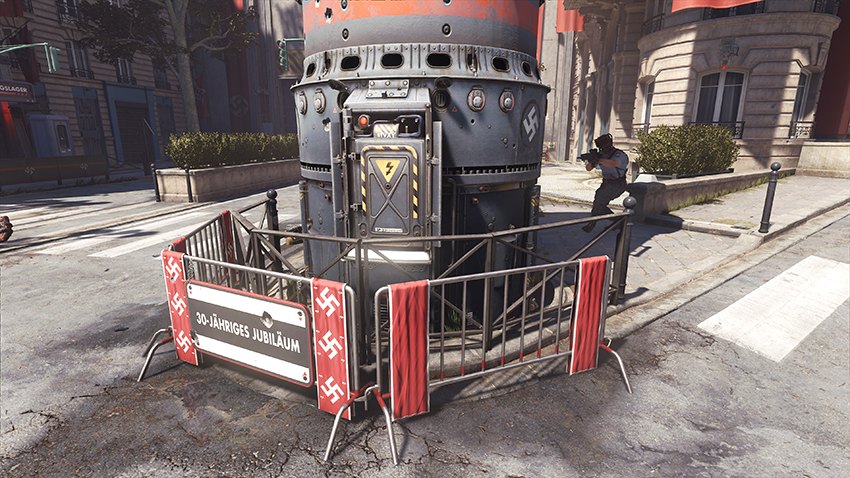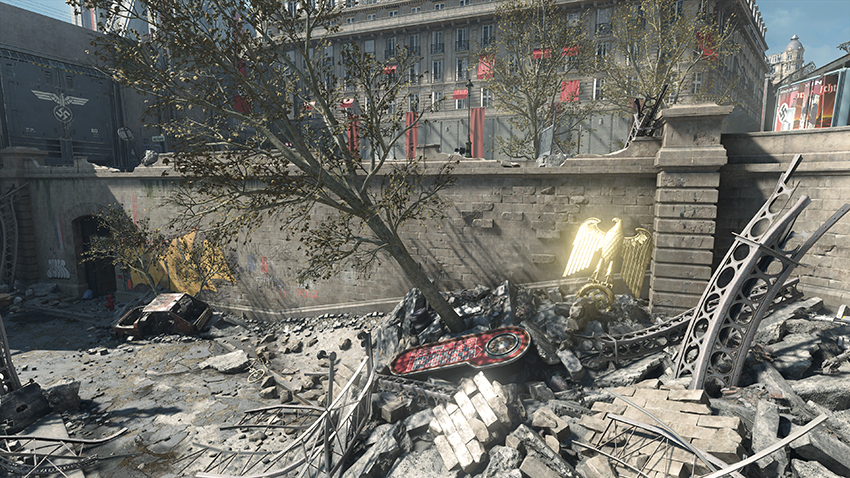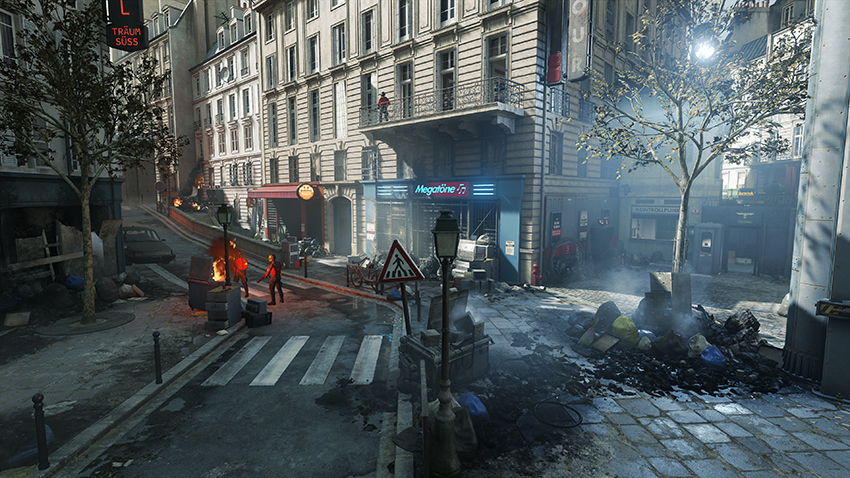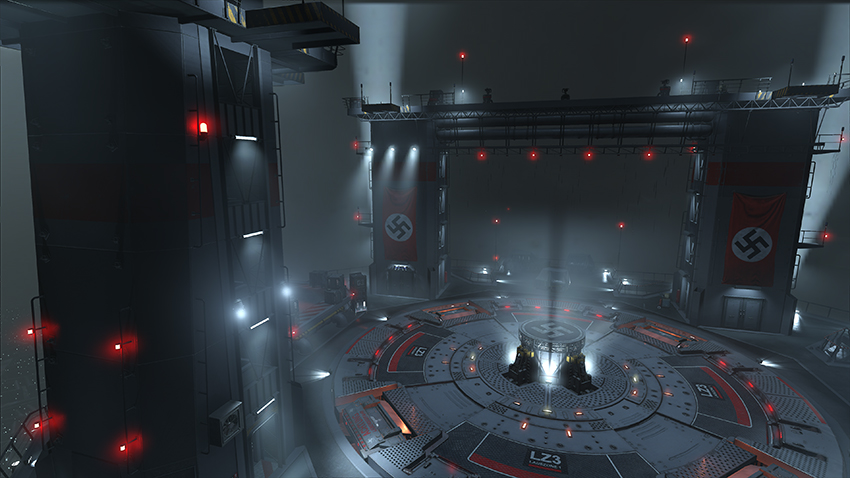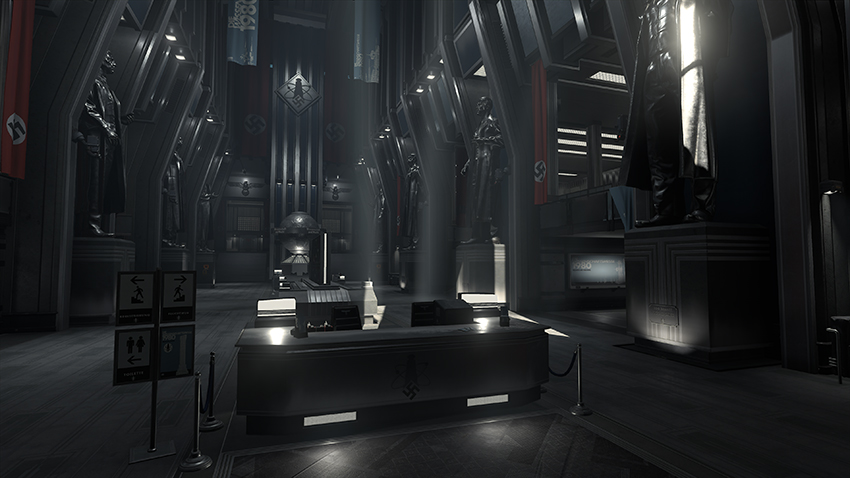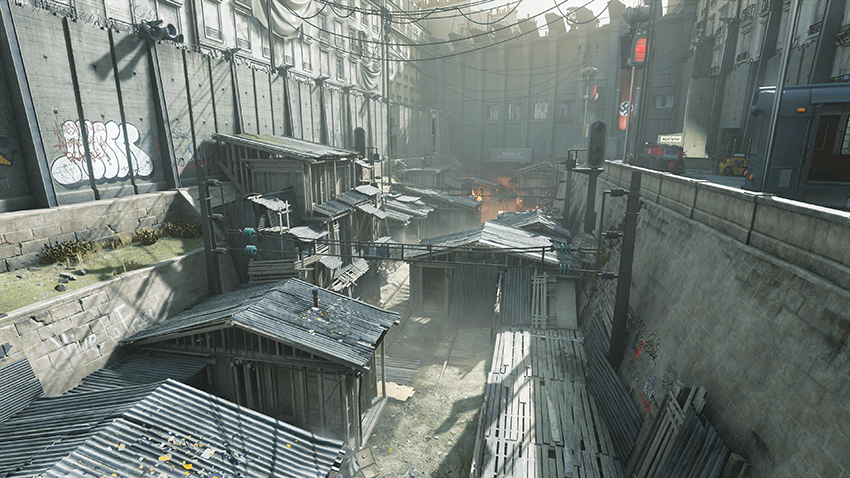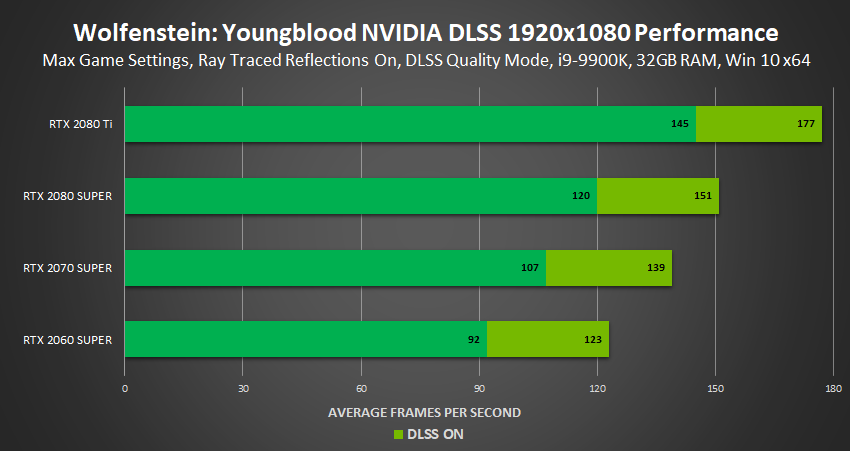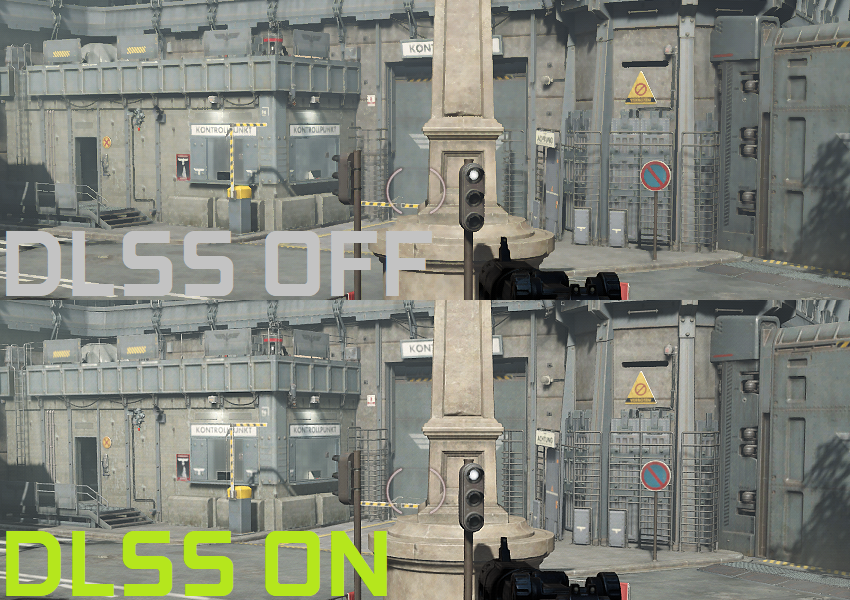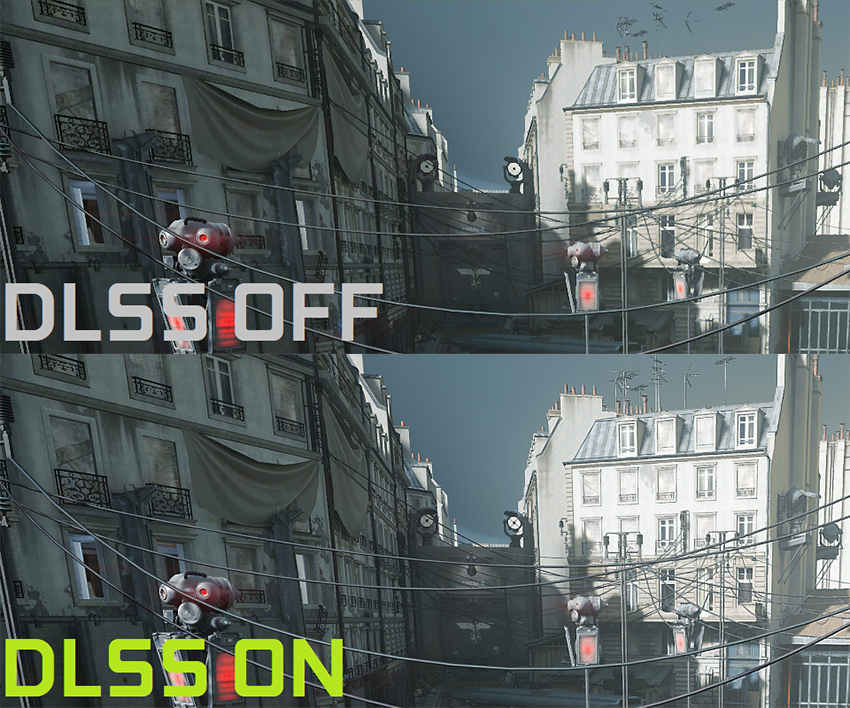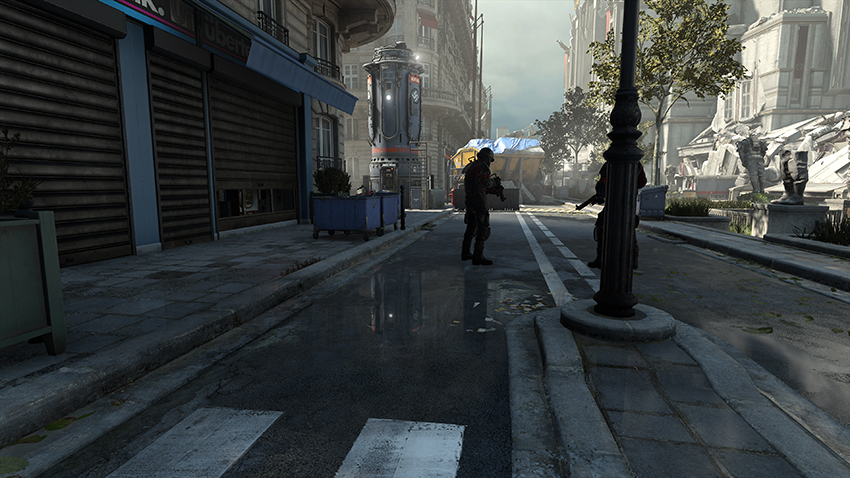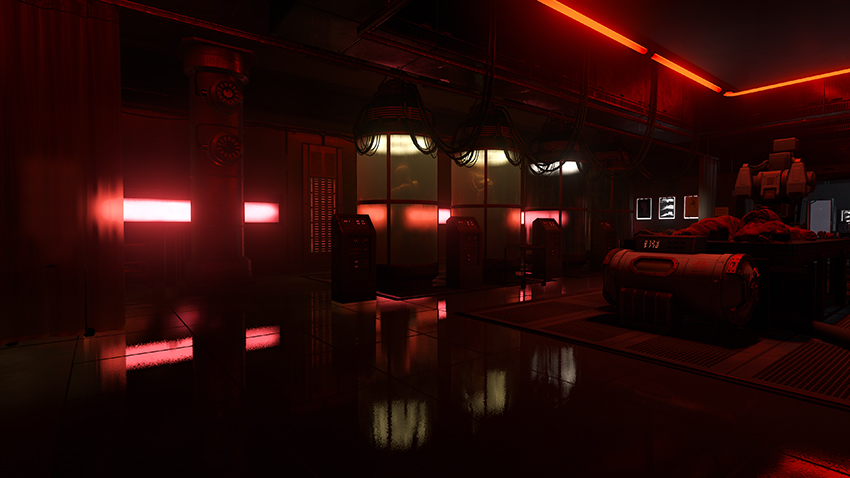Wolfenstein: Youngblood Graphics and Performance Guide
MachineGames' Wolfenstein: Youngblood launched July 26th, with the franchise's first ever co-op campaign, and its first open-plan levels, enabling you to tackle challenges and enemies with unprecedented freedom.
Using the venerable id Tech engine, Wolfenstein: Youngblood runs at high resolutions and detail levels on many systems. And performance is further accelerated by NVIDIA Adaptive Shading, which can boost framerates by as much as 20%, with no perceptible effect on image quality.
So, get comfy and prepare to delve into Wolfenstein: Youngblood's PC settings and enhancements, with examinations of each, using interactive comparison screenshots, relative performance charts, and written explainers, giving you all the info you need to tweak and tailor your graphics and performance.
Guide Contents:
- NVIDIA RTX Ray Tracing
- Graphics Settings
- Anti-Aliasing
- Async Compute
- Decal Filtering
- Decals
- Deferred Rendering
- Depth of Field
- Depth of Field Anti-Aliasing
- Directional Occlusion
- GPU Culling
- HDR Bloom
- Image Aniso Filter
- Image Streaming
- Lightmap Aniso Filter
- Lights
- LOD Switch
- Material Aniso Filter
- Motion Blur
- NVIDIA Adaptive Shading
- NVIDIA DLSS
- Particles
- Reflections
- Ray Traced Reflections
- Resolution Scale
- Shadows
- Sharpening
- Volumetric Quality
- Water Quality
- Settings Wrap-Up
- GeForce Experience: Optimal Playable Settings With A Single Click
- Wolfenstein: Youngblood Game Ready Driver
- Conclusion
Ray-Traced Effects Available Now In Wolfenstein: Youngblood
Bethesda Softworks and MachineGames have chosen NVIDIA GeForce as the PC platform of choice for Wolfenstein: Youngblood, giving us the opportunity to enhance Wolfenstein: Youngblood with realistic Ray-Traced Reflections.
In Wolfenstein: Youngblood, Ray-Traced Reflections will accurately simulate the way light reflects on glossy and metal surfaces by tracing a single bounce of reflection rays across the scene. Materials affected include smooth, natural mirrors, like windows and water, but also rougher surfaces like brushed metal. Unlike screen space techniques, which can only reflect what’s on screen, ray-traced reflections incorporate the entire scene around the character, and can accurately represent objects outside the camera view, as well as those facing away from the camera. These reflections will enhance everything, from street scenes to secret labs, to casinos and control centers.
To experience these effects for yourself, grab the latest game update, and configure graphics options as detailed here.
Wolfenstein: Youngblood Graphics Settings
Wolfenstein: Youngblood includes nearly 30 settings that affect image quality and performance, giving you plenty to configure and tweak in your quest for the definitive experience. For all the details, keep reading.
Anti-Aliasing
Anti-Aliasing reduces the visibility of jagged edges, and nowadays many techniques also include a Temporal Anti-Aliasing component, counteracting shimmering and crawling seen on anti-aliased edges when they or the camera moves.
In Wolfenstein: Youngblood, six anti-aliasing options are available. Some are slightly sharper, and some have slightly better anti-aliasing properties on different game elements, but all you really need to know is that TSSAA 8TX is superior to all other AA settings, and should be enabled on all systems that aren't struggling for performance.
Looking at the interactive comparisons below, you'll see that TSSAA 8TX has greatly improved anti-aliasing (immediately noticeable on the lamppost), the clarity and sharpness of textures is maintained better than with other techniques, shiny specular details are less muted, and with its 8 Temporal Anti-Aliasing samples, versus the single sample used by the other TAA techniques, TSSAA 8TX does a great job of keeping the action clear and shimmer free while you're playing.
Having played and tested the entire game, here's our succinct summary: if you want the best overall AA, use TSSAA 8x; if you want the best TAA, use TSSAA 8x; and if you want to use normal AA instead, select SMAA.
Performance: The delta between TSSAA 8TX and Off is just shy of 10 FPS; a relatively high number in today's world of 2-3 FPS post-process anti-aliasing. Hopefully though, you'll agree the cost is worth it, as TSSAA 8TX does a much better job than the other AA techniques.

One final anti-aliasing note: to make the results softer or sharper, you can apply additional post-process sharpening via the dedicated Sharpening setting, examined later in this guide. All screenshots above were taken with the default Sharpening value, 2.
Async Compute
Asynchronous computing allows the GPU to perform multiple tasks simultaneously, rather than waiting for one to be finished before the next is started. This accelerates workloads, meaning your framerate increases, unless your GPU's performance is limited by a CPU bottleneck.
In Wolfenstein: Youngblood, enabling Async Compute can improve performance by 6-10% on Turing-architecture GPUs, in most instances, though the level of speed up will be reduced on prior-generation GPUs with less efficient asynchronous capabilities.

Decal Filtering
Most game engines have a single Anisotropic Filtering option, enabling players to increase the sharpness of textures seen in the distance and on the edges of the screen. In Wolfenstein: Youngblood, there are four AF options, the first of which is "Decal Filtering".
In game terms, a Decal is a scorch mark, a bullet hole, or some other effect applied to a textured surface. In our example below, focus exclusively on the road marking to the right of the enemy's foot, and you'll observe that it's clearer, sharper and more detailed with filtering set to 16x:
Performance: With a barely perceptible performance cost, that is well within the margin of error for benchmarks, there's no good reason to reduce the fidelity and clarity of decals, many of which you'll see throughout this action-packed FPS.

Decals
The second decals setting affects the quality and visibility of bullet impacts and the like. In the interactive comparison below, look to the checkpoint and swipe the slider back and forth: when the setting is lowered, less decals are visible, making it appear that your actions have little effect on the world.
| Interactive Comparisons | ||
| Ultra vs. High | Ultra vs. Medium | High vs. Medium |
Performance: With a minimal performance cost, maxing out the Decal setting is recommended.

Deferred Rendering
In short, Deferred Rendering delays shading until a later part in the graphics pipeline, resulting in performance improvements for some configurations.
On our test bench, the benefit is just over 2 FPS, but do note that this setting cannot be used in conjunction with NVIDIA Adaptive Shading, which delivers far larger gains on Turing-architecture GPUs.
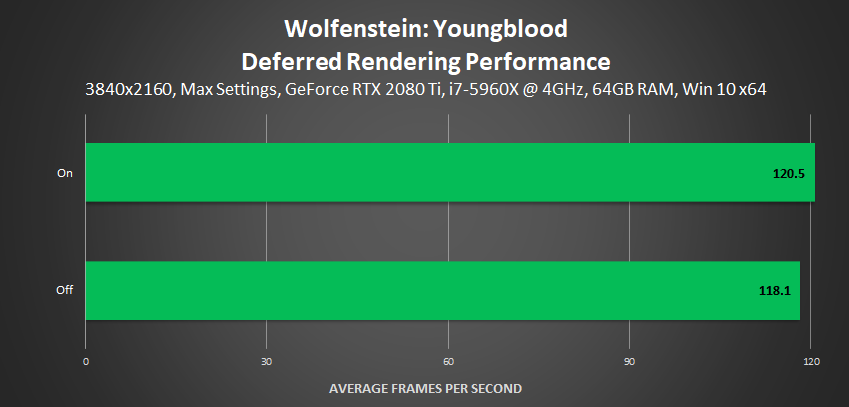
Depth of Field
This tricky-to-benchmark setting applies some out of focus blurring at select moments during the game, maybe having a performance cost of around 5 FPS at 4K.
If you're looking for performance gains, switching Depth of Field off will certainly help, and you're unlikely to notice its absence.
Depth of Field Anti-Aliasing
When "Depth of Field" is enabled, this extra anti-aliasing setting can smooth out any rough edges where out of focus detail meets in focus detail. And best we can tell, it has a minimal extra cost, so if you decide to use DoF, this shouldn't affect framerates to any noticeable degree.
Directional Occlusion
Wolfenstein: Youngblood's take on Ambient Occlusion is Directional Occlusion. Three detail levels are on offer, and in static comparisons the differences between levels can be summarised as, "darker, more accurate shadowing". In motion though, higher quality levels look a fair bit better as they have fewer temporal artifacts, therefore appearing more realistic.
| Interactive Comparisons | ||
| High vs. Medium | High vs. Low | High vs. Off |
| Medium vs. Low | Medium vs. Off | Low vs. Off |
In darker areas, Directional Occlusion continues to improve image quality, though the benefits of higher details levels are diminished.
| Interactive Comparisons | ||
| High vs. Medium | High vs. Low | High vs. Off |
| Medium vs. Low | Medium vs. Off | Low vs. Off |
In detailed scenes, with objects behind objects, behind objects, the benefits of higher detail levels can be more pronounced. The differences, though, never approach the magnitude of say SSAO versus HBAO+ in the other games we've examined over the years.
| Interactive Comparisons | ||
| High vs. Medium | High vs. Low | High vs. Off |
| Medium vs. Low | Medium vs. Off | Low vs. Off |
Performance: Directional Occlusion is one of the more important settings, having an impact on image quality throughout every moment of the game, so even if you're struggling for performance, it's recommended you enable at least Low so objects are grounded, and the world is shadowed more realistically.
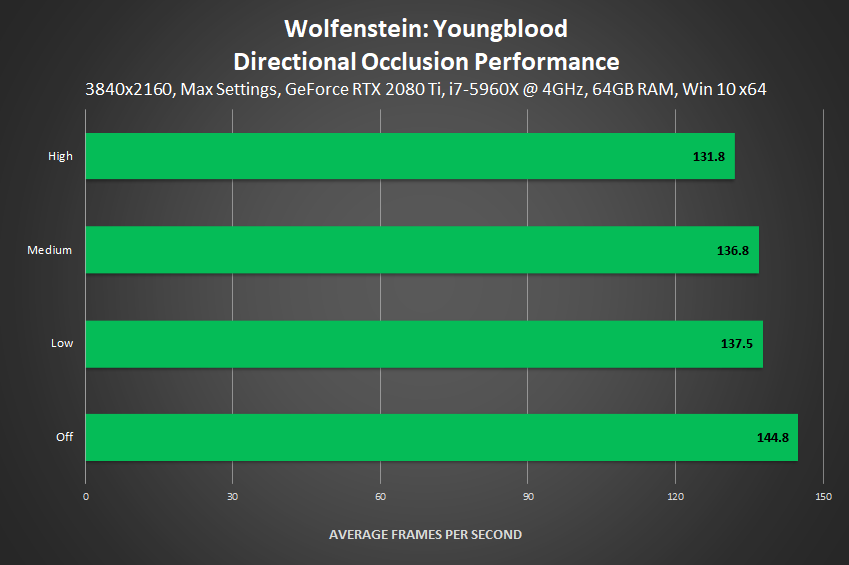
If your performance is higher, but not high enough for your tastes, consider dropping from High to Medium, which offers good AO coverage for 5 FPS less.
GPU Culling
This setting renders only the detail in the player's in-game field of view. However, on modern NVIDIA graphics cards, our GPU architectures are more efficient at this at a global level, resulting in a loss of performance when enabling "GPU Culling". As such, we recommend switching-off GPU Culling.
HDR Bloom
Lights, sunlight, and other effects gain a bright, bloomy glow with HDR Bloom enabled, as demonstrated below.
Performance: The post-process HDR Bloom effect has a minimal cost in the highly performant Wolfenstein: Youngblood.

Image Aniso Filter
The second Anisotropic Filtering setting is a mystery, described in-game as affecting "remaining image types". Dozens of locations were tested and compared under a magnifier, and to date we've yet to find a single visual or performance difference between Trilinear and 16x filtering, so we'd recommend just leaving Image Aniso Filter at max quality for the duration.
Image Streaming
Essentially, Image Streaming is a Texture Quality setting combined with a texture loading setting, affecting not only the fidelity of textures, but the speed at which new textures load in.
If you've got a modern GPU with 6-8GB of VRAM, set Image Streaming to Uber or Ultra, and only turn it down if you notice delays in textures loading, or stuttering and pausing from repeated memory swapping. At these detail levels, everything is crisp and clear, and no texture pop-in is observed while sprinting at max speeds.
On lower detail levels, the quality of select textures begins to be reduced. In our example below, the quality of the statue and gambling table are greatly reduced; the advertising poster isn't as detailed or as sharp; the road texture is slightly blurrier; and the quality of the textures on geometry and debris is microscopically lower.
More importantly, textures can take longer to load in, and scenery in the distance can be distractingly blurry, affecting realism and immersion.
Performance: With no other bells and whistles tied to the Image Streaming setting, the level of detail you select should be dictated by your GPU's VRAM. With 8GB or more, everything should be gravy at 4K, though those with 6GB may find they need to drop to Ultra. If you have less than 6GB, we recommend limiting your gaming to Ultra at 1920x1080 or 2560x1440.
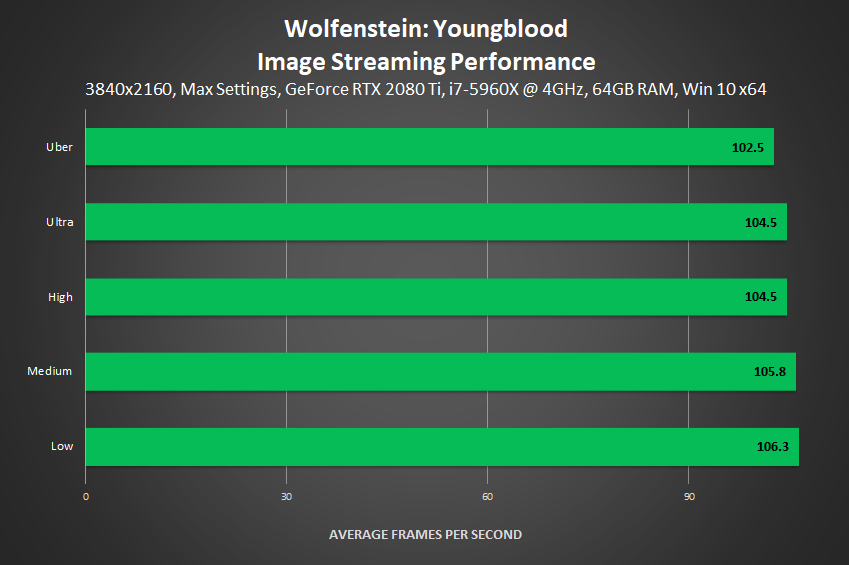
Lightmap Aniso Filter
Our next Anisotropic Filtering setting adjusts the clarity of the lightmaps applied to environments. However, whether you're up close or far away from affected surfaces, you'll struggle to find any difference between the available options, without the aid of a magnifying glass.
| Interactive Comparisons | ||
| Anisotropic 4x vs. Anisotropic 2x | Anisotropic 4x vs. Trilinear | Anisotropic 2x vs. Trilinear |
| Interactive Comparisons | ||
| Anisotropic 4x vs. Anisotropic 2x | Anisotropic 4x vs. Trilinear | Anisotropic 2x vs. Trilinear |
Performance: Though the visual difference may be impossible to discern during gameplay, there is a measurable performance cost, albeit a minute one:
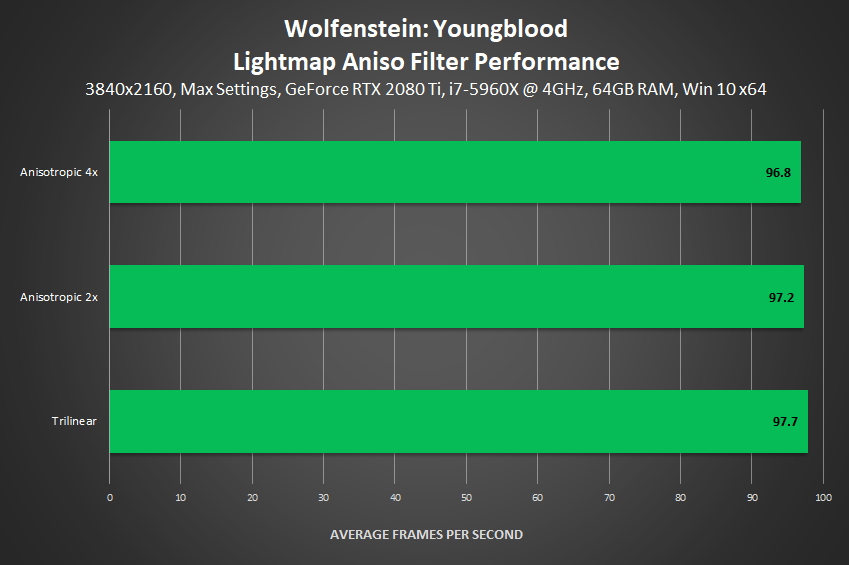
Lights
In Wolfenstein: Youngblood, the Lights setting controls how many lights illuminate the world, the quality of their lighting, and how many are lit.
Our example below demonstrates the full impact of this setting, with lights further from the camera turned off at each step. In other areas though, and those primarily illuminated by daylight, the differences are less dramatic and far less visible.
| Interactive Comparisons | ||
| Ultra vs. High | Ultra vs. Medium | Ultra vs. Low |
| High vs. Medium | High vs. Low | Medium vs. Low |
Performance: In scenes such as the one shown above, Lights is the most demanding setting in the game, decreasing performance by over 20 FPS at its maximum detail level. In others, though, it has a lesser impact. As such, you'll find that many levels and locations perform better than in our test.

In Wolfenstein: Youngblood, stepping down from a setting's max detail level to its next highest typically provides a noticeable performance uplift with minimal impact to image quality. With Lights, this holds true in many locations, but in scenes such as the one shown above you ideally want max quality.
LOD Switch
We've been unable to measure or observe any change in image quality or performance using this level of detail setting, so simply set it to max to ensure objects and game elements load at high levels of detail at all times.
Material Aniso Filter
Material Aniso Filter, the final Anisotropic Filter setting, is a traditional Texture Filter setting, improving the clarity of textures seen at a distance or on an angle.
Performance: Anisotropic Filtering is generally a 'free' setting, having little to no performance cost. Here, however, there's a 7 FPS delta between 16x and Trilinear.

Despite the perf gains with lower settings, 16x is something you should enable regardless, unless you want your textures blurry for the duration of the game...
Motion Blur
Along with an On-Off toggle, there's also a Motion Blur Quality setting, improving the fidelity of the blurring effect. As this can't be reliably tested, we're guesstimating that there's a 4-7 FPS delta between the minimum and maximum Motion Blur quality presets.
NVIDIA Adaptive Shading
GeForce RTX 20-Series GPUs are powered by our advanced Turing architecture, which makes real-time ray tracing a reality. Furthermore, Turing is the first and only architecture to offer support for Variable Rate Shading, Mesh Shading, and other technologies that make games look and play better.
In Wolfenstein: Youngblood, we utilise Variable Rate Shading (VRS) and some NVIDIA magic to improve performance by up to 20%, with zero downsides.
In-game, you'll want to enable "NVIDIA Adaptive Shading" (NAS), our custom setting that combines the Content Adaptive Shading (CAS) and Motion Adaptive Shading (MAS) VRS techniques with some additional engineering. Together, they detect areas of the screen that don't require full-rate shading.
For instance, in a dark corner you can't see any detail, so why shade at maximum quality, or even shade at all? And if you or the camera are moving at speed, and perhaps with Motion Blur enabled, too, why shade detail at full quality when you won't be able to see it? Using this logic, we can shade individual pixels less frequently, with no perceptible reduction in quality, boosting performance 'for free'.
Using a debug option, we can demonstrate NVIDIA Adaptive Shading in a scene from Wolfenstein: Youngblood. Balanced, Quality and Performance presets adjust the amount of variable rate shading, and the extent to which affected areas are less frequently shaded, shown in our debug images in different colours. Blue means the shading rate is 2x lower, green 4x lower, and yellow 8x lower:
In this garage scene, the application of NVIDIA Adaptive Shading increases performance by 9% when using Balanced, our recommended setting, and by 12.6% when using Performance:

Looking at the scene without the debug overlay enabled, there is no perceptible loss of quality when using Balanced or Quality, though the more aggressive Performance mode does introduce a few blemishes that a trained eye will spot in static comparisons:
Depending on the scene, performance gains from NVIDIA Adaptive Shading may increase or decrease. For example, this dark and moody locale sees a 12.1% uplift when using Balanced, an 8.3% improvement with Quality, and a 17% boost with Performance:
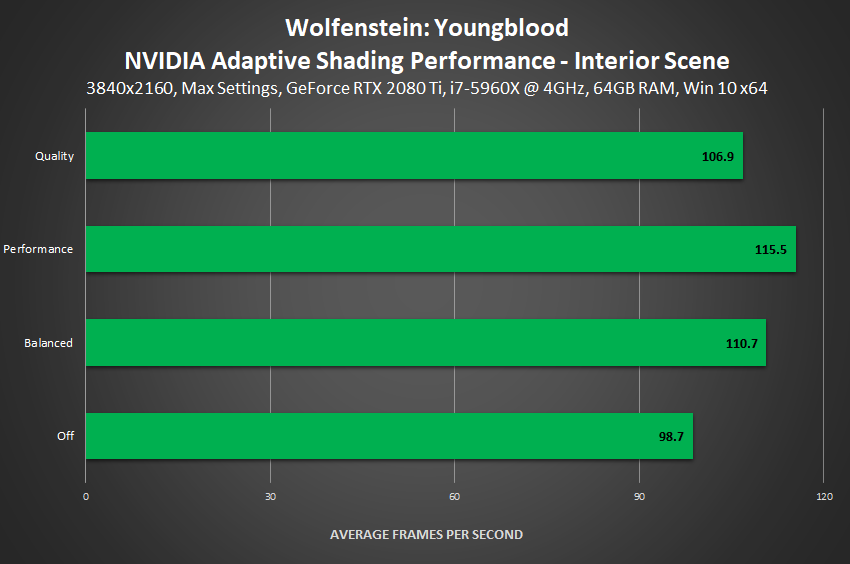
This bright, daylight scene, sees gains of only 1-3%, however, as the content aware NVIDIA Adaptive Shading technology knows that the shading rate cannot be reduced without compromising quality.
As well as the listed gains, further improvements can be found during gameplay when the player or camera is moving, and when Motion Blur is enabled, thanks to Motion Adaptive Shading. Learn more in our tech explainer, and check out our GDC presentation if you want the complete lowdown on NVIDIA Adaptive Shading.
In summary, set it and forget it: NVIDIA Adaptive Shading set to Balanced will improve performance by 10-20% in the vast majority of the game's levels and locations, with no perceptible reduction in image quality, and without further user intervention or tweaking.
But if you do want to tweak, set NAS to Custom and adjust the sliders that tell the game when, where and how to use variable rate shading.
Particles
Shoot robotic enemies, and other game elements, and particles will be emitted, making fights look more interesting and dynamic. Using the Particles setting, the number and quality of these particles can be adjusted.
As with some other settings, making a repeatable benchmark is nigh on impossible, so we're guesstimating based on our many hours of gameplay and testing that Ultra runs around 10 FPS slower than Low in the biggest battles, and that High is a few FPS faster than Ultra with only a minimal change in image quality.
Reflections
Puddles, select metal surfaces, glossy floors, and other material types feature Screen Space Reflections, showing real-time reflections of surrounding action and game elements:
| Interactive Comparisons | ||
| Ultra vs. High | Ultra vs. Medium | Ultra vs. Low |
| High vs. Medium | High vs. Low | Medium vs. Low |
As you can see, most geometric detail is retained on everything but Low, which essentially disables all reflectivity.
In our next set of comparisons, you can see the ever-improving accuracy of shadows when the quality setting is raised step by step from Low to Ultra:
| Interactive Comparisons | ||
| Ultra vs. High | Ultra vs. Medium | Ultra vs. Low |
| High vs. Medium | High vs. Low | Medium vs. Low |
In our final set of comparisons, Reflections enhance the walls, floor and ceiling, though not the windows:
| Interactive Comparisons | ||
| Ultra vs. High | Ultra vs. Medium | Ultra vs. Low |
| High vs. Medium | High vs. Low | Medium vs. Low |
Elsewhere, reflections can be found on large bodies of water, like those shown later in this guide. In those instances, the Reflections setting has no impact on reflected world detail, or on dynamic reflections seen on the water's surface. Nor do they affect reflections on windows and other surfaces, which use cubemaps to approximate reflected detail at a minimal performance cost.
Performance: For a good balance between performance and quality, High is recommended. And while Low's minimal cost is appealing, its use isn't recommended due to the reduction in image quality on innumerable surfaces.

Ray Traced Reflections
As of January 9th, 2020, if you have the latest Game Ready Driver, Windows 10 update and game patch installed, you can enable realistic real-time ray traced reflections in Wolfenstein: Youngblood.
Navigate to Options > Video > Advanced Settings, scroll down, switch Ray Traced Reflections on, and restart the game when prompted. At the same time, you can also enable NVIDIA DLSS, and select the DLSS Mode, boosting performance greatly.
With Wolfenstein: Youngblood running at high framerates on all GeForce RTX graphics cards, ray tracing is possible at all resolutions, even 4K. And with DLSS enabled, performance is accelerated by a significant degree, enabling you to enjoy massively improved ray-traced graphics at over 100 FPS at 4K, and at over 150 FPS at lower resolutions:
With ray tracing enabled, every location with even a hint of reflectivity is enhanced by the new ray traced reflections, adding realistic, real-time detail to windows, water, objects, enemies, and much more. And with DLSS, not only do you get improved anti-aliasing, as detailed earlier, you also receive a massive increase to performance, offsetting the cost of the cutting-edge, high-fidelity reflections that improve fidelity, realism and immersion throughout the entireity of Wolfenstein: Youngblood.
Resolution Scale
Using in-game options to adjust the rendering resolution is increasingly common, though Wolfenstein: Youngblood takes it a step further by offering players a dynamic option that temporarily decreases the resolution to return performance to an acceptable state. If you're on an entry-level machine, it's well worth enabling to avoid any nasty slowdowns during high intensity moments.
Shadows
Unsurprisingly, the Shadows setting changes the quality and visibility of shadows. In Wolfenstein: Youngblood, only Uber and Ultra bear looking at, as they cast shadows across medium and long-range views, as demonstrated on the steps to the right of our interactive comparisons. And as you'll observe, only Uber has nicely-defined, highly detailed shadowing, making it the setting you ideally want to use.
Performance: Given the significant improvement to image quality, we can only recommend the use of Uber, which runs just 9 FPS slower than Low.

Sharpening
Applying post-process anti-aliasing, and downscaling the rendering resolution, makes gameplay blurrier. To counteract this loss of clarity, you can enable Sharpening via a slider. By default, the slider sits at the mid-point, 2.0, tackling most of the added blur without introducing additional aliasing.
| Interactive Comparisons (TSSAA 8TX Anti-Aliasing) | ||
| 4.0 vs. 3.0 | 4.0 vs. 2.0 | 4.0 vs. 1.0 |
| 4.0 vs. Off | 3.0 vs. 2.0 | 3.0 vs. 1.0 |
| 3.0 vs. Off | 2.0 vs. 1.0 | 2.0 vs. Off |
| 1.0 vs. Off | ||
| Interactive Comparisons (TSSAA 8TX Anti-Aliasing) | ||
| 4.0 vs. 3.0 | 4.0 vs. 2.0 | 4.0 vs. 1.0 |
| 4.0 vs. Off | 3.0 vs. 2.0 | 3.0 vs. 1.0 |
| 3.0 vs. Off | 2.0 vs. 1.0 | 2.0 vs. Off |
| 1.0 vs. Off | ||
Performance: Regardless of whether you apply a little or a lot of sharpening, the post-process effect has zero impact on performance.

Volumetric Quality
Wolfenstein: Youngblood's volumetric effects are generally found where bright light illuminates an area, exemplified in the three examples below. By raising their fidelity from Medium to High, they blend with the scenery more realistically, eliminating the shadowy blemishes a keen observer may notice (the artifacts around the "Halt" pillar in our first comparison, for example):
Performance: During gameplay, you'd be hard-pushed to notice these blemishes, so if you need to extract additional performance to raise your framerate, dropping from High to Medium is an easy way to recover a few FPS.

Water Quality
Set in and around Paris, there's a fair bit of water to be found in Wolfenstein: Youngblood, and using the Water Quality setting its fidelity can be adjusted. Specifically, items affected include, the quality of the water simulation, the quality of the reflections seen on the water's surface, the ability for water to affect the appearance of surrounding game elements, and whether the water's surface correctly blocks the display of underwater detail.
In our first set of comparisons, Ultra and High are virtually identical, with only a small change in sim quality visible towards the back of the scene. Medium further reduces sim quality and removes some distant and peripheral detail, while Low disables or reduces the quality of just about everything.
| Interactive Comparisons | ||
| Ultra vs. High | Ultra vs. Medium | Ultra vs. Low |
| High vs. Medium | High vs. Low | Medium vs. Low |
Elsewhere, Ultra and High are indistinguishable, Medium affects shading and shadowing (around the boat, for example), and Low once again switches everything off.
| Interactive Comparisons | ||
| Ultra vs. High | Ultra vs. Medium | Ultra vs. Low |
| High vs. Medium | High vs. Low | Medium vs. Low |
Performance: If one ignores Low, the cost of Water Quality is comparatively low, though if you did need to save a few frames here and there, High offers nearly identical fidelity to Ultra.

Settings Wrap-Up
As was the case with previous Wolfenstein games, framerates are sky high on most modern GPUs at 1920x1080 and 2560x1440, even with max settings enabled:
If, however, you want to make framerates even better, there are several quick changes you can make:
- Directional Occlusion: Medium instead of High
- Image Streaming: Ultra instead of Uber
- Motion Blur: Turn down the quality, or disable entirely
- Particles: High instead of Ultra
- Reflections: High instead of Ultra
- Volumetric Quality: Medium instead of High
- Water Quality: High instead of Ultra
Together, these changes boost performance in our benchmarks by nearly 20 FPS, and if you want to take things further you could use Ultra Shadows instead of Uber, turn lights down to High, and switch NVIDIA Adaptive Shading to Performance, though these additional changes would affect image quality.
In conclusion, virtually any supported GPU can attain a playable Wolfenstein: Youngblood experience, and a vast number of modern GPUs will deliver excellent fidelity and framerates at 1920x1080 and 2560x1440. But if you want that ultimate 4K experience, with everything set to 11, running at 60 FPS, you'll need, at minimum, an overclocked GeForce GTX 1080, a GeForce GTX 1080 Ti, or a GeForce RTX 2060.
GeForce Experience: Optimal Playable Settings With A Single Click
If you don't wish to manually adjust settings, the best way to automatically configure Wolfenstein: Youngblood for a smooth, enjoyable experience is through GeForce Experience, an invaluable tool for all GeForce users. In addition to optimising Wolfenstein: Youngblood and over 700 other games, the free GeForce Experience application can automatically update drivers and profiles, and record and stream gameplay with ShadowPlay.
Taking into account your GPU and CPU, as well as many additional factors, GeForce Experience's game recommendations can be applied with a single click and are updated over time should developer patches and NVIDIA driver updates improve performance further still. This one-click solution is perfect for gamers who wish to simply play their games, and for those with little experience in configuring settings for an optimal experience.
Game Ready Wolfenstein: Youngblood Driver
For the best Wolfenstein: Youngblood experience we recommend updating your system with the Wolfenstein: Youngblood GeForce Game Ready Driver. This includes day-1 optimisations and fixes, and will ensure the best possible experience from the second you start playing. To download, head to the Drivers tab in GeForce Experience, or download manually from our website.
The Definitive Wolfenstein: Youngblood Experience
With faster framerates, higher levels of detail, realistic ray tracing, and performance-boosting NVIDIA DLSS, the PC edition of Wolfenstein: Youngblood offers gamers the definitive experience.
To get Wolfenstein: Youngblood, head to the Bethesda store.
